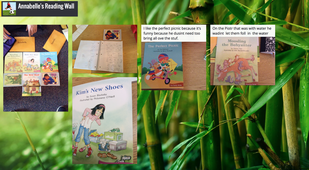Our Reading Walls
|
It's important that our youngest readers learn how to read, but it is equally important that they begin to consider their lives as readers. As we work together this year we work to balance our conversations between learning how to read and getting to know ourselves as readers. What do we like to read? Do we have favorite authors? What kinds of books do we enjoy? Who are our reading friends? What are we reading now? What do we hope to read next?
For this reason, instead of having calendars signed we will be keeping a reading wall. Our wall is digital and housed on Padlet. We are archiving the books we read together on our walls. Padlet will allow us to add pictures, video, or writing about our reading worlds. Students can add books, favorite reading spaces, or other information about their reading lives. Students may, but are not required to, add books they read at home or in the classroom. Students have a QR code and web address on their reading bags/totes. To access their wall you just need to type the web address into a browser or take a picture of the QR code with a tablet or smart phone. Students know how to add to their wall, but if you have questions please let me know. |
Home Reading
|
Growing Independent Readers: Monitoring
An often overlooked behavior for readers is monitoring. Self-monitoring is an important beginning step in growing as a reader. A reader who monitors makes sure his/her reading makes sense and looks right. These readers notice when something doesn't look quite right, and attempt to fix it. You will often notice your child stopping when they notice something doesn't seem right. Your child may even go back and reread to try to figure out what needs fixed.
As parents, how can you support this behavior with home reading? Here are a few suggestions:
1. Let the reader do the work. When you notice your child has made an error, wait. I recommend waiting until the end of the page. If there is a lot of text on a page, try to wait until the end of the paragraph. This gives your child a chance to correct the error independently.
2. Prompt. If your child keeps reading and doesn't notice the error, at the end of the page or section say something like:
3. Praise. Sometimes praise your child for the smart work he/she did as a reader.
As parents, how can you support this behavior with home reading? Here are a few suggestions:
1. Let the reader do the work. When you notice your child has made an error, wait. I recommend waiting until the end of the page. If there is a lot of text on a page, try to wait until the end of the paragraph. This gives your child a chance to correct the error independently.
2. Prompt. If your child keeps reading and doesn't notice the error, at the end of the page or section say something like:
- What you said made sense, but it didn't look right.
- What you said looked right, but it didn't make sense.
- Try that again, something wasn't quite right.
3. Praise. Sometimes praise your child for the smart work he/she did as a reader.
- "You noticed that wasn't quite right." (They may not always be able to fix it.)
- "You worked hard here to make your reading make sense and look right."
- "Wow! How did you fix that?"
Downloading Digital titles from the Library
Many of you asked about downloading digital books for loan from the library. Downloading Overdrive on your tablet, iPad or phone, will allow you to choose and borrow books from the library. The tutorial "Using Overdrive" should help, but if you have problems please let me know. The library is also always very helpful with getting this started.
